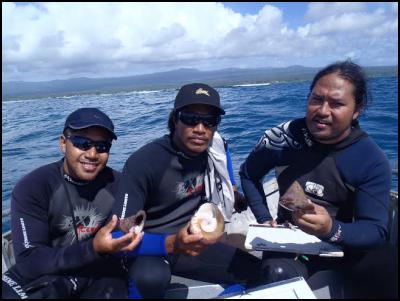Trochus - a New Coastal Fisheries Resource for Samoa
Trochus - a New Coastal Fisheries Resource for Samoa

Samoa is the latest country to successfully develop a new trochus (Tectus niloticus) fishery. On learning of the successful introduction of the species in Federated States of Micronesia, Marshall Islands, Cook Islands and French Polynesia, the Government of Samoa began its effort to introduce the species in the 1990s. Despite some initial losses, introductions in 2003 and 2006 of stocks from Fiji and Vanuatu have succeeded. Assessments conducted by the Secretariat of the Pacific Community (SPC) and the Samoa Fisheries Division in June 2014 (led by SPC Fisheries Scientist Kalo Pakoa) recovered good numbers of live shells on the reefs of Upolu Island from Fangaloa Bay in the south all the way to Manono in the north.
Trochus is valued for its meat and its shell, which is used to make buttons, jewelry and handicrafts. In countries such as Fiji, Vanuatu, Solomon Islands and Papua New Guinea, there are factories that process trochus shells for export, handling around 100 to 200 tonnes annually. The main markets for these products are Italy, Korea and Japan. Its meat is a source of protein for the coastal people and it can also be sold at the local market. Because of the demand, stocks have been heavily fished in many of its natural locations, and translocation of wild stocks has been an effective management option.
Trochus is one of the most mobilised wild marine stocks in the Pacific Islands region. Since the 1920s over 100 wild stock translocations and introductions have been made between reefs, islands and countries to locations where original stocks have been overexploited and to new reefs in islands and countries wanting to develop the resource. The ability of the shellfish to survive a few days out of water makes it possible to transport trochus over long distances from source locations by road, sea and air. To date, concerns about the introduction of the species in the Pacific Islands have been minimal, and the species continues to be moved around today.
While the resource is yet to be fully developed in Samoa, a new trochus fishery has emerged. Since 2009, harvesting of trochus has become a new coastal fisheries activity for the people of Upolu Island. The meat, eaten at home or sold at roadside markets, is consumed raw in sea water mixed with other invertebrates and is sold in bottles at WST 15.00 to WST 25.00 per bottle for small to large bottles. Landed quantities of meat for 2009 and 2010 were 410 kg and 764 kg. The shells are not being utilised at this stage; making use of the shell could double or triple the current value of the shellfish.
Now that the resource had established, the next step is to put in place management measures to allow the resource to fully develop and fishing activities to be sustainable. SPC is working with Samoa Fisheries Division to develop a new trochus fishery management plan. This work is supported by the European Union-funded SciCOFish (Scientific Support for the Management of Oceanic Fisheries in the Pacific Islands Region) project.
ENDS


 Carbon Market Watch: Going For Green - Is The Paris Olympics Winning The Race Against The Climate Clock?
Carbon Market Watch: Going For Green - Is The Paris Olympics Winning The Race Against The Climate Clock? New Zealand Defence Force: NZDF Working With Pacific Neighbours To Support Solomon Islands Election
New Zealand Defence Force: NZDF Working With Pacific Neighbours To Support Solomon Islands Election UN News: Ceasefire The Only Way To End Killing And Injuring Of Children In Gaza
UN News: Ceasefire The Only Way To End Killing And Injuring Of Children In Gaza ICHRP: US-Japan-Philippines Trilateral Summit Makes The Philippines A Battlefield For US-China Conflict
ICHRP: US-Japan-Philippines Trilateral Summit Makes The Philippines A Battlefield For US-China Conflict East West Center: Environmental Journalist Alexander Kaufman Receives East-West Center’s Inaugural Melvin M.S. Goo Writing Fellowship
East West Center: Environmental Journalist Alexander Kaufman Receives East-West Center’s Inaugural Melvin M.S. Goo Writing Fellowship Compassion in World Farming: Octopus Farm Must Be Stopped, Say Campaigners
Compassion in World Farming: Octopus Farm Must Be Stopped, Say Campaigners